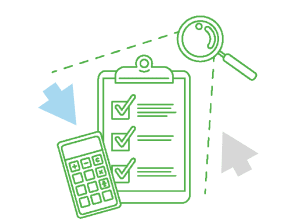From this article, you will learn:
- Who should be involved in the process of implementing KSeF in a company?
- What the consequences of incorrect or late implementation of KSeF are?
- How big the scale of changes resulting from the modification of the invoice issuing process can be?
The adoption of the National e-Invoicing System (KSeF) will become mandatory for taxpayers starting from July 1st, 2024. This new system will revolutionise the sales invoicing process and introduce changes to the circulation of invoices in Poland, so given the scope and scale of the changes, it is worth starting one's preparations early. Here are several steps that companies should take when implementing the KSeF.
If you are in charge of implementing KSeF in an organization, then, approaching the problem according to the best practices in project management, try to use these four steps below.
Step one: identify and precisely describe the aims of the project
Even if you deal with projects of a similar scale on a daily basis, then in the case of KSeF you should first reflect on where you start and where you have to end. Divide the project into stages and set the measurable goals which you have to achieve, describe the challenges you can encounter, and which can be an obstacle in achieving the goals. Thanks to this, you will have a reasonable indicator of the implementation of the project assumptions.
The obvious and primary aim of the KSeF implementation project is that, as of July 1, 2024, your company will be able to issue invoices according to the current requirements in this area. Tentatively, we can divide this process into two stages:
The preparatory stage
The preparatory stage has two aims:
- the identification of obligatory and optional fields in the schema and changes necessary to introduce in the processes;
- the assessment of utility and possibility of adapting the current tool used to issue invoices, that is determining whether you will be able to use the current tool, or if you have to develop it or consider purchasing a new one.
To obtain reliable results, it is necessary to:
- analyse the procedures regarding sales which are currently applied in a company, especially the procedures related to issuing sales invoices and correcting invoices;
- analyse sales invoices and correcting invoices with regard to the new schema, that is the logical structure of an e-invoice;
- conduct technical analysis of the system currently used to issue sales invoices and correcting invoices as well as the possibility of integrating it with KSeF;
- analyse the current authentication and authorization model within the context of the credentials verification model in KSeF;
The implementation stage
The implementation stage includes three aspects:
- implementing IT solutions;
- training the staff how to issue and receive invoices in KSeF;
- establishing a new scheme of document flow based on the electronic exchange of documents.
In order to achieve the best results, it is necessary to:
- prepare the tools to issue sales and correction invoices for integration with KSeF;
- train the workers issuing sales invoices with regard to system changes and schema requirements;
- prepare the workers in charge of issuing invoices for authentication and authorization of invoice dispatch in KSeF (e-signature, ePUAP);
- verify and adjust the contracts with counterparties and accounting offices.
It is worth realizing that the main assumption of the KSeF system is unification of data included in invoices and elimination of paper invoices from circulation. It is a shift towards modern solutions which have many advantages. However, for the taxpayers these changes mean that the tax authorities will have a direct access to the information they could not access before.
Learn more about related services
Step two: identify all the stakeholders
In this step reflect on who will benefit if the project succeeds and who will be adversely affected if the project fails. Thanks to identifying the stakeholders you will realize who you and your team answer to, which will also help you to see the price of success and failure.
Because of the fact that the obligatory KSeF system basically serves invoice issuing and reception, it connects internal and external stakeholders. The first, internal stakeholder who cares about the proper implementation of the project, is a department that issues sales invoices (since it puts invoices into the circulation and is directly responsible for their correctness).
Moreover, the implementation regards the IT system on which the sales department operates, therefore, the IT department becomes another internal stakeholder since it is responsible for the proper functioning of these systems. At last, the final recipients of the documents like sales and purchase invoices are accounting, finance, tax and settlement departments which account the taxes based on these documents.
External stakeholders are recipients of invoices (that is, services and goods provided by your company), who care about receiving an error-free invoice within the right time frame.
It is also worth noticing that in the projects regarding compulsory changes in reporting data to the tax offices or other institutions, the key stakeholders can also be management board and owners who bear the highest costs resulting from faulty implementation of changes (these may be financial penalties, loss of clients or even penal-fiscal consequences).
Step three: define the roles and duties of implementation participants
Excess of duties and prolonged processes are the worst enemies of good project management. If you plan the details of project implementation, make sure the tasks assigned to the members of your team do not overlap. Remember, everyone should be focused on the topic that matches their abilities.
As can be seen, the implementation of the KSeF system is a process in which you have to combine substantive and technical knowledge. It means that the efficient implementing of KSeF will require the involvement of workers from all the departments of a company. These should be the people who:
- participate in the processes regarding sales invoicing and work with customers or suppliers;
- implement and maintain the IT systems and their key modules;
- participate in booking purchase and sales invoices, deal with tax settlements.
In relation to this, at the beginning take care of the appropriate selection of members in your team. Do not expect that the accounting department will replace the IT department or that the sales department will replace the tax specialists. The bigger the company is, the larger your team should be. Assign the roles clearly, with an emphasis on the fact that the invoicing, tax and accounting specialists are substantive support for the IT department, but it is still the IT department which has to do a technical review of the tools and takes the responsibility for the implementation of new solutions. Try to make sure that all the team members exchange information with each other at various stages of the project.
Step four: define project assumptions, risks and dependencies
Understanding all the sensitive areas of the project plan will help you to adjust if problems arise. Reflect on what assumptions you make and then determine whether they are reasonable or not. Identify the risk related to making a wrong assumption or judgement. Finally, consider which elements on the map of your project are dependent on each other. If one step requires taking another one, then focus on the first part before beginning the dependent phase.
Undoubtedly a sensitive area in the case of the KSeF project is the final version of the e-invoice structure which will be applied (because it is still being consulted and the Ministry of Finance is introducing further changes to the Act).
Some of the key areas of the National System of e-Invoices are also waiting for the explanation from the Ministry of Finance. However, the fact is, that the time for implementing the new process of invoicing is relatively short, and therefore, it is reasonable to begin the project of implementation even with underspecified assumptions, because making corrections will take less effort and stress than implementing all the required solutions at the last minute. In this way, you will minimize the risk of a total failure which would prevent issuing sales invoices.
The stage of the project regarding the analysis of systems and procedures operating until now should begin as soon as possible, because further decisions and implementation stages depend on the results of it.
We hope that using this short guidebook will help to achieve the goal faster and implement KSeF in an organization effectively.





